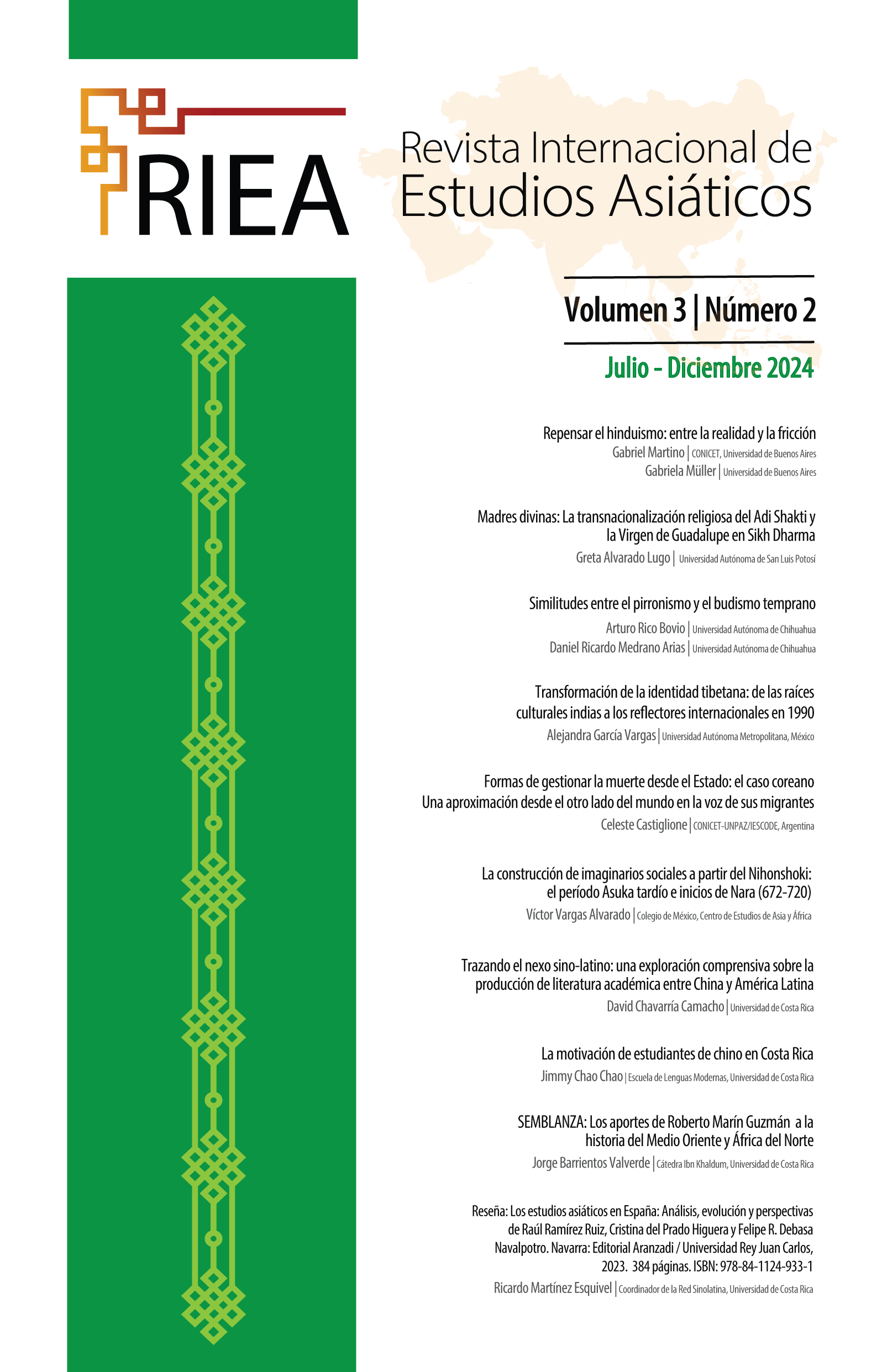Abstract
This essay examines the possible relationships that have been pointed out between Pyrrhonian skepticism and early Buddhism. After providing a brief historical overview of each philosophy, the results of the examination of the primary sources are presented in order to highlight the points of convergence and the differences found, offering more precise hypotheses about the similarities. Since it is feasible to consider interactions in both directions, the results of this initial exploration may be useful for scholars of Greek philosophy. Those engaged in reconstructing the history of Buddhism, and for contributing to the reflection on the links between East and West.
References
Aísa, Isabel. “Del escepticismo helenístico al escepticismo actual: la charlatanería”. Cuadernos de los Amigos de los Museos de Osuna No. 18 (2016): 189-192.
Beckwith I., Christopher. Greek Buddha: Pyrrho’s Encounter with Early Buddhism in Central Asia. (New Jersey: Princeton University Press, 2015).
Bharadwaja, V. K. “Rationality, Argumentation and Embarrassment: A Study of Four Logical Alternatives (catuṣkoṭi) in Buddhist Logic”. Philosophy East and West 34, no. 3 (1984).
Brun, Jean. El Estoicismo. México: UNAM, 1997.
Buswell Jr., Robert E., y Lopez Jr., Donald S. The Princeton Dictionary of Buddhism. Nueva Jersey: Princeton University Press, 2014
Díaz Martín, Eduardo. “El Escepticismo en la antigüedad”. Historia de la filosofía antigua. Madrid: Trotta, 2013.
Empírico, Sexto. Esbozos Pirrónicos. Madrid: Gredos, 1993.
Ferrater Mora, José. Diccionario de filosofía. Argentina: Sudamericana, 1965.
Flintoff, Ernest. “Pyrrho and India”. Phronesis 25 (1980). 88-108.
Fogelin, Lars. An Archaeological History of Indian Buddhism. Nueva York: Oxford University Press, 2015.
Gallego Cao, Antonio y Muñoz Diego, Teresa. “Influencia de los «Esbozos Pirrónicos» en la filosofía moderna” en Esbozos Pirrónicos. (Madrid: Gredos, 1993), 7-47.
Gunaratne, R. D. “The Logical Form of Catuṣkoṭi: A New Solution”. Philosophy East and West, 30, no. 2 (1980), 211-239.
———, “Understanding Nāgārjuna's Catuṣkoṭi”, Philosophy East and West 36, no. 3 (1986), 213-234.
Harvey, Peter. An Introduction to Buddhism: Teachings, History and Practices 2da ed. Reino Unido: Cambridge University Press, 2013.
Hegel. Lecciones sobre la historia de la filosofía. Ciudad de México: Fondo de Cultura Económica, 2021.
Hirakawa, Akira. A History of Indian Buddhism: From Sakyamuni to Early Mahayan. Estados Unidos: University of Hawaii, 1990.
Jayatilleke K. N. Early Buddhist Theory of Knowledge. Londres: George Allen and Unwin LTD, 1963.
———“The Logic of Four Alternatives”. Philosophy East and West, Vol. 17, No. 1/4 (1967), 69-83.
Kuzminski, Adrian. Pyrrhonism: How the Ancient Greeks Reinvented Buddhism. Reino Unido: Lexington Books, 2008.
Laercio, Diógenes. Vida de los filósofos ilustres. Madrid: Alianza, 2007.
Lorenza Chiesara, Maria. Historia del escepticismo griego. España: Siruela, 2007.
Lorenzen N. David y Preciado Solís, Benjamín. “Las escuelas no védicas”. En Atadura y liberación: las religiones de la India. México: Colegio de México, 2003, 51-84.
M. Rosental y P. Iudin. Diccionario filosófico abreviado. Montevideo: Pueblos Unidos, 1959.
Mejía Peroni, Luciano. “En búsqueda de los orígenes del escepticismo pirrónico: Comparación entre el pirronismo y el budismo mādhyamika”. Monografía de grado: Universidad de Los Andes, 2017, 1-51.
Pellegrin, Pierre. “Sextus Empiricus” en The Cambridge Companion to Ancient Scepticism. Nueva York: Cambridge University Press, 2010, 120-141.
Priest, Graham. The Fifth Corner of Four: An Essay on Buddhist Metaphysics and the Catuskoti. Reino Unido: Oxford University Press, 2018.
Rigopoulos, Antonio. “The Avyākatāni and the Catuṣkoṭi Form in the Pāli Sutta Piṭaka, 2.” East and West, 43, no. ¼. (1993), 115-140.
Román Alcalá, Ramón. “Los nombres del escepticismo antiguo: aporētikoí, ephektikoí, pyrrhōneioi, skeptikoí y zētētikoí”. Anales del Seminario de Historia de la Filosofía, 38, no. 3. (2021), 431-439.
Ronkin, Noa. Early Budhist Metaphysics: The making of a philosophy. Estados Unidos: Routledge Curzon, 2005.
Ruegg Seyfort, David. “The Uses of the Four Positions of the Catuskoti and the Problem of the Description of Reality in Mahayana Buddhism”. Journal of Indian Philosophy 5. (1977), 1-71.
Traducido por Isidatta. “Sonassuta”. Anguttaranikaya. (https://suttacentral.net/an6.55/es/isidatta?reference=none&highlight=false), 2012.
Traducido por Solé-Leris, Amadeo y Vélez de Cea, Abraham. Majjhima Nikaya: Los sermones medios del Buddha. España: Kairos, 1999.
Westerhoff, Jan. “Madhyamaka and Modern Western Philosophy: A Report” Buddhist Studies Review 33 (2017). 281-302.
———. “Nagarjuna´s Catuskoti”. Journal of Indian Philosophy 34 (2006). 367-395.
———. “The Catuskoti or Tetralemma”. Nagarjuna´s Madhyamaka: A Philosophical Introduction. Nueva York: Oxford, 2009.
———. “Nāgārjuna and the Philosophy of Language”. Journal of Indian Philosophy 47 (2019). 779-793.


